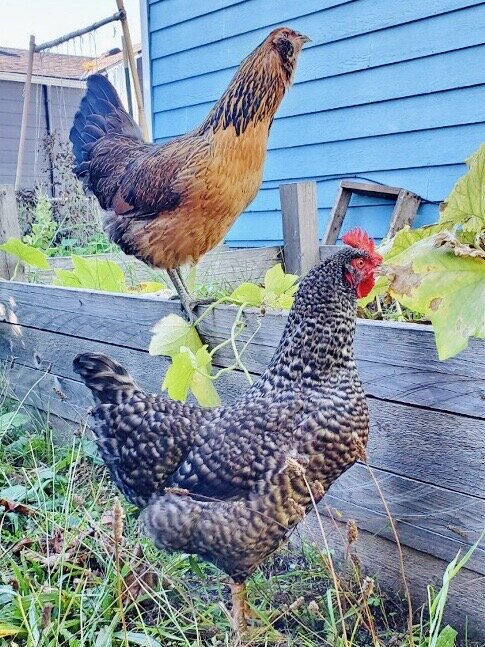Cracking Open a Few Eggs
This past spring I crashed with my brother and his fiance, Peyton, for many weeks to avoid some of the quarantine loneliness that can come with living alone. During this time, Peyton and I planted vegetable seeds, planned a big garden, and to round out her little urban farm, she was able to get two chicks, Agatha and Ethel. These two chickens have quickly become the biggest characters on the property, and their domain over the backyard is both adorable and terrifying (for the local cats) at times. While I have since returned to my own apartment life, Agatha and Ethel are all grown up and eating and laying well. They snack on food scraps, lay eggs, and Peyton uses their droppings as manure—it’s considered the gold standard of fertilizer for gardeners. Unfortunately most eggs that are available nationwide are not grown in small circular systems like Peyton’s backyard. In this article we’ll cover why someone might opt to include eggs in their sustainable diet, how eggs can be part of a sustainable system, and how you can learn about how eggs were produced by deciphering labels on egg cartons. All the labels might leave your brain feeling a bit scrambled, but we hope this article helps clarify things a bit!
Nutritional Value of Eggs
As a self identified “flexitarian,” eggs are a wonderful protein source that I can feel good about eating. I am also allergic to soy, so finding affordable vegetarian protein sources can be tough (beans get monotonous after a while, okay?), and eggs are a great option. We all know the classic cliché of bodybuilders guzzling down raw eggs, and that’s because they really are a great addition to a healthy diet (perhaps in more moderation than those body-builders though). Eggs have one of the lowest calorie to protein ratios and are full of great vitamins like B12. That being said, there’s been a lot of historic debate about cholesterol in eggs, which has resulted in some ambivalence toward them, but it seems to have died down. You can read more about the nutrition content of eggs if that’s your thing, here.
Eggs as Part of a Sustainable System
We’re not here to say that eggs are the most sustainable product on the market, but they can be sourced sustainably, and compared to other animal products, they are relatively low impact. In an idealized system, like Peyton’s yard, chickens can consume food scraps that might otherwise go in the compost, snack on bugs in the grass, and fertilize the soil for next year’s crops. When I traveled to Belize in the winter of 2019 to study school gardens there, chickens ran around most backyards and were a part of most family’s food production. This is how many small farmers use chickens in their production sequence. The sun feeds the plants, the plants attract pests, the pests feed the chicken, and the chicken feeds the plants with nitrogen. This sustainable, circular agriculture system has been around for centuries, but was made famous in the popular book The Omnivore's Dilemma by Michael Pollan (we definitely recommend!).
As well as occupying a role in a circular agricultural system, chicken and eggs can be found nearly everywhere and can be sourced locally most of the year. Eggs are often easy to find at farmers markets at an affordable price, and can be a way to support local farmers in the winter when some of their crops are dormant.
Egg Labeling
Okay, so let’s say you’ve decided that you’re up for eating eggs as part of your vegetarian, flexitarian, or whatever-atarian diet, for better or for worse you’ll soon find out you have a ton of options. While many eggs at the farmers market aren’t officially labeled, you can ask your farmer about how they were raised. If you’re headed to the supermarket, you may come across lots of labels on the carton. These labels can only give you a hint at the quality of the eggs themselves, as well as the conditions the chickens were in while laying them. And when I say “hint”, I really do mean it. We’ve outlined some definitions below in language that we find clear, but you’ll notice that many of the definitions themselves are purposefully vague. These vague definitions allow large scale operations to use terms like “free-range” and other labels without fully embracing the best practices for animal welfare and sustainability. (Let’s just say that your standard “free range” chicken is not running around a backyard like Agatha and Ethel, okay?)
Color: There is no nutritional difference between brown and white eggs. Brown eggs are more expensive than white eggs because of the difference in the hens that lay them. White eggs are laid by chickens with white feathers and white earlobes, while brown eggs are laid by red-feathered chickens with red earlobes. Chickens with red feathers are larger in body size and require more feed which is why brown eggs are more expensive on store shelves.
Free range: There are no uniform standards for free-range labeled eggs which are produced on farms where hens have some access to the outdoors. The hens only need to have access to the outdoors and there are no specifications for the amount of space per hen for a farm to qualify for this label. These eggs are usually more expensive, due to higher production costs and the lower volume of eggs per farm, as well as marketing appeal of these eggs.
Grade A, Grade AA: Eggs are graded based on their quality and appearance. Grade AA eggs have thick, firm whites and high, round yolks. Their shells are clean and unbroken. Grade A eggs are like Grade AA, but their whites are "reasonably" firm. Grade A eggs are usually sold in stores. Grade B eggs are lower quality, and have thin whites and wider yolks and their shells may show slight stains.
Vegetarian fed: Vegetarian Fed eggs are produced from hens fed a vegetarian diet and are not limited to a specific housing style. Chickens are natural omnivores, meaning they will eat foods of both animal (like bugs!) and plant origin if not on a controlled diet, therefore, this label is typically not applicable for pasture and free range eggs.
Organic: Organic eggs are produced by hens fed and housed according to the United States Department of Agriculture established organic standards for diet and other special requirements such as access to the outdoors. For more information on production guidelines for organic eggs, visit USDA’s National Organic Program.
Refrigeration: It turns out that, here in America, eggs are refrigerated because the USDA requires eggs sold for consumption to be washed, processed, and then refrigerated before they come anywhere near a store’s shelves. On the other hand, most European and Asian countries have reached the opposite conclusion, requiring that table eggs not be wet-washed, and also not refrigerated. Read more about how this developed and how it affects how long your eggs last, here.
So what are our recommendations?
Eat eggs if you’ve decided that works for you as part of your diet. We don’t recommend eating eggs at every meal, but if you’re not a vegan, they can be a good option for local sustainable protein. If you do opt for eating eggs, we recommend trying to find local eggs, and be sure to ask many questions about how the chickens are raised—it’s usually only a few more dollars per dozen. If you’re opting for supermarket eggs, definitely take a peek at the labels and make the right choice for your ethics and your budget.
Sources:
https://www.bestfoodfacts.org/food-facts-what-is-the-difference-between-white-and-brown-eggs/
https://www.organicvalley.coop/blog/why-does-us-refrigerate-eggs/
https://www.webmd.com/diet/features/good-eggs-for-nutrition-theyre-hard-to-beat
https://www.mindbodygreen.com/0-28163/heres-what-to-eat-and-what-not-to-to-save-the-environment.html





